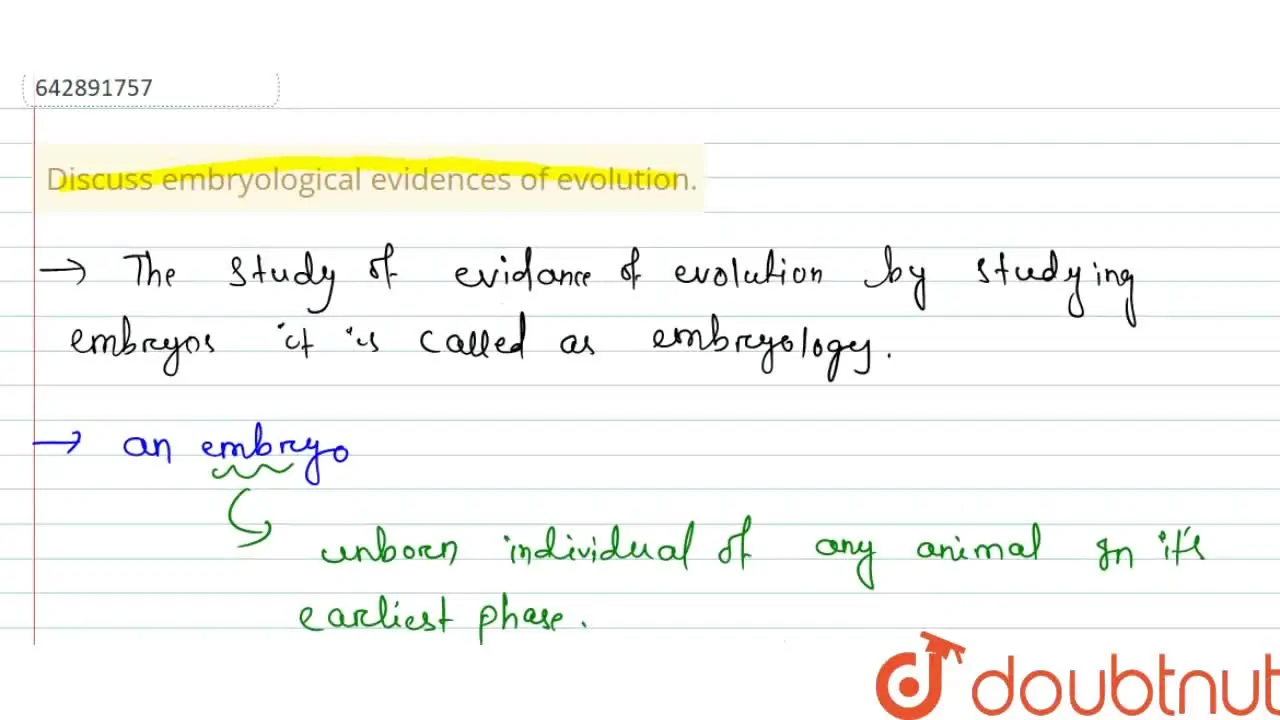Discuss embryological evidences of evolution.Solution in Odia
Evidences from embryology The similarities in the embryonic development process of different groups of animals and their embryos provide most conclusive evidences supporting organic evolution. These similarites indicate that evolution of organisms occurs through a common pathway. These studies also suggest a degree of intimacy in the relationships among different groups of animals. The following conclusions are derived from the study of comparative embryology. Common pattern of development In the process of sexual reproduction, all multicellular animals produce a diploid zygote. After fertilisation, the zygote undergoes cleavage to form a solid ball of cells called morula. The morula then forms a single-layered embryo called blastula which then develops into a two or three-layered gastrula. Differentiation of tissues and organogenesis occur after the formation of gastrula. This results in the formation of various organs. This is a common pattern of development in the animal kingdom with similar stages. This justifies presence of a common ancestry. Similarity in early embryos of vertebrates A comparative study of the early embryos of different vertebrates, such as fish, salamander, lizard, opposum, monkey and human reveals a striking similarities in the early embryos. These similarities are so alike that it becomes difficult to distinguish them from each other. They all possess external gills, notochord, tail-like structures and other similar organs. Development of organs like heart, brain, lungs, ear, alimentary canal, etc. in the vertebrates occurs essentially in the same manner. As development progresses, the embryos develop specialised characters and they gradually appear different. Similarities like these in early embryos suggest that all these animals share common ancestry. Embryological Evidence in Plants
Protonema, a moss is similar to certain green algae suggests that the mosses might has evolved from the later. Primitive gymnosperms like Cycas and Ginkgo possess have ciliated sperms like those of pteridophytes. It is therefore, believed that gymnosperms have evolved from pteridophytes.
Related Playlists
- BOOK - ARIHANT PUBLICATIONCHAPTER - SAMPLE PAPER 2EXERCISE - SECTION B(ZOOLOGY) (GROUP III) (SHORT NOTE)4videos
SAMPLE PAPER 2
- BOOK - ARIHANT PUBLICATIONCHAPTER - SAMPLE PAPER 2EXERCISE - SECTION B(ZOOLOGY) (GROUP II)9videos
SAMPLE PAPER 2
- BOOK - ARIHANT PUBLICATIONCHAPTER - SAMPLE PAPER 1EXERCISE - SECTION B(ZOOLOGY) (Group III)7videos
SAMPLE PAPER 1
- BOOK - ARIHANT PUBLICATIONCHAPTER - SAMPLE PAPER 3EXERCISE - Section B (Zoology) Group III7videos
SAMPLE PAPER 3
Similar Questions
Proliferative phase of menstrual cycle
03:34View SolutionWhat are indigenous poultry breeds? Mention any two bacterial and viral diseases each of poultry.
02:20View SolutionDescribe the characteristics of sex-linked inheritance and write about Y-linked traits in humans beings. Name any two disorders that occur due to sex-linked inheritance.
View SolutionDescribe the structure of DNA studied by Watson and Crick.
View SolutionDiscuss the anatomical or embryological evidences of biological evolution
View SolutionWhat is the supportive evidence for evolution from comparative embryology?
02:36View SolutionHow do the following evidences contribute to the theory of evolution? Embryological evidences
01:36View SolutionEmbryological evidences provide proof of evolution. Explain.
02:33View SolutionHow is embryological evidence of evolution studied?
02:07View SolutionHow does the embryological evidences support that Evolution has taken place?
03:40View Solutionwho disapproved the theory of embryological evidence as to the evidence of evolution ?
06:36View SolutionExplain the evidences of evolution from Embryology.
View SolutionDescribe in brief the embryological evidences in support of organic evolution
05:02View SolutionDiscuss the anatomical or embryological evidences of biological evolution.
02:43View SolutionExplain embryological evidences to support the organic evolution.
04:02View SolutionFrom the following, which animal group is studied for embryological evidence for the evidences for Evolution?
05:42View Solution


